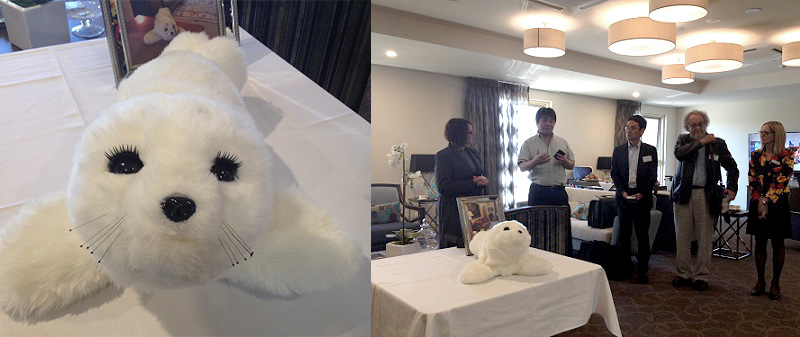Sitting in her favourite armchair in the sunshine at Aurrum Brunswick, an elderly lady gently stroked the fluffy white fur of the creature in her lap. She spoke softly to it and in return, the creature lifted its head and made friendly, almost lifelike sounds in return.
She had made a new friend – in the form of PARO, a robotic baby harp seal. PARO is described by its inventor, Dr Takanori Shibata as “a therapeutic companion robot, designed to improve sociability and communication between patients and caregivers.”
“A seal was chosen because no one has a preconceived idea of how a seal should behave – unlike cats and dogs” says Dr. Shibata.
PARO is a robot seal covered in pure white synthetic fur with built-in intelligence providing psychological, physiological, and social effects through physical interaction with humans. Inside are two 23-bit CPUs (central processing units), which can process voice recognition and imitate animal behaviour, enabling PARO to develop its own character. PARO has five different types of sensors over the body that allows it to perceive people and the environment, and respond to touch, light, sound, temperature and posture.
Weighing about the same as a newborn baby, PARO has the ability to learn new words and remember the voices different people. At Aurrum Brunswick alone, PARO is regularly spoken to in Greek and Italian as well as English.
PARO has been proven as a stimulating and engaging tool for dementia sufferers all over the world. There are over 300’000 people in Australia living with dementia, with that number expected to rise significantly over the next decade, so the introduction of PARO to the Australian market is great news for family members and carers of dementia patients.
John’s 65 year old mother is a resident at Aurrum Reservoir and he says since being introduced to PARO, his mother is happier than ever.
“When I saw her this morning, I left the room for about five minutes and when I came back in to sit with her she said ‘Are you still here? I’ve got my PARO now – I don’t need you anymore!’” he says laughing.
“Whenever PARO is around the smile on her face is just beautiful. She gets excited. She’s happy.”
Aurrum is planning to make use of PARO across all of its sites in Vitoria and New South Wales. “We wanted to take part in a good quality initiative,” says Area General Manager, Glenda Walker.
Not only is PARO extremely practical and therapeutic for people with dementia, research has also shown that it alleviates the symptoms of people who suffer from depression and anxiety and in some cases even reduces the need for medication.
PARO was developed in 1993 by Dr Takanori Shibata and officially released commercially in Japan in 2005. In 2009 PARO was introduced to Europe, with Denmark at the forefront of adopting this innovative technology.
“I’ve been working on a few different kinds of PARO, each designed for specific purposes. For example, this PARO here is great therapy for elderly people, especially those suffering with dementia.” Dr. Shibata says.
“In the cases for children with autism or Downs Syndrome, I’ve been developing a PARO that can be used to train children in social skills. There’s also ones in development to deal specifically with developmental problems and psychological problems.”
Professor Peter Disler is an accomplished senior physician and academic at the University of Melbourne and has seen the positive effects of PARO first hand in his work with Aurrum.
“I know as well as anyone how difficult it is to deal with the behavioural side of things with people with dementia.” He says.
“There’s so many electronic devices nowadays, that memory is becoming largely irrelevant. But behaviour is a real challenge, and whatever we have to improve it, is good. Through my observations, I’ve found an improvement in behaviour and satisfaction amongst residents and a generally high acceptance of PARO. I think it’s a fantastic thing.”
View source article: agedcareonline.com.au/2015/01/PARO-The-Therapeutic-Robot-Helping-The-Elderly
